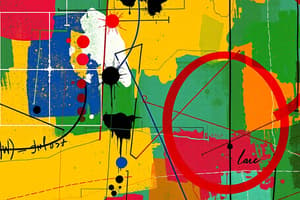Podcast
Questions and Answers
What defines the domain of a relation?
What defines the domain of a relation?
- The set of all X-components of the ordered pairs. (correct)
- The set of all Y-components of the ordered pairs.
- The relationship between X and Y values.
- The output values associated with each input value.
Which of the following represents a function?
Which of the following represents a function?
- {(5,1), (5,2), (6,1)}
- {(1,2), (1,3), (2,4)}
- {(2,2), (3,3), (4,4)} (correct)
- {(0,0), (1,1), (1,2)}
What is the range of the relation {(1,3), (2,4), (5,6), (7,8)}?
What is the range of the relation {(1,3), (2,4), (5,6), (7,8)}?
- {1, 2, 3, 4}
- {3, 4, 6, 8} (correct)
- {2, 4, 5, 7}
- {3, 4, 6, 8} (correct)
What is the purpose of the vertical line test?
What is the purpose of the vertical line test?
Which of the following scenarios does NOT represent a one-to-one function?
Which of the following scenarios does NOT represent a one-to-one function?
Given the relation {(1,0), (0,1), (-1,0), (0,-1)}, is it a function?
Given the relation {(1,0), (0,1), (-1,0), (0,-1)}, is it a function?
Which of the following is NOT a representation of functions?
Which of the following is NOT a representation of functions?
Identify the domain of the relation {(-2,1), (0,-1), (5,3), (0,7)}.
Identify the domain of the relation {(-2,1), (0,-1), (5,3), (0,7)}.
Flashcards are hidden until you start studying
Study Notes
Functions and Relations
- Definitions
- A relation is a set of ordered pairs (x, y).
- The domain consists of all x-components (independent variable).
- The range consists of all y-components (dependent variable).
Ordered Pairs Example
-
Given ordered pairs: {(1, 3), (2, 4), (5, 6), (7, 8)}
- Domain: {1, 2, 5, 7}
- Range: {3, 4, 6, 8}
-
Another set of ordered pairs: {(-2, 1), (0, -1), (5, 3), (0, 7)}
- Domain: {-2, 0, 5}
- Range: {1, -1, 3, 7}
Function Characteristics
- A function maps each element of set x to exactly one element in set y.
Function Representations
-
Mapping (One-to-One)
- Each domain value corresponds to one unique range value.
-
Mapping (One-to-Many)
- A single domain value corresponds to multiple range values.
-
Mapping (Many-to-One)
- Multiple domain values correspond to a single range value.
Function Validation
-
Function Test: Ordered pairs
- {(1, 1), (2, 2), (3, 3), (4, 4)} is a function.
- {(1, 0), (0, 1), (-1, 0), (0, -1)} is not a function (0 cannot map to both 1 and -1).
-
Table of values validation
- For table with x: -1, 0, 1, 2 and y: 2, -2, 3, 3 - not a function due to the value 3 being repeated for different x-values.
Graphical Representation
- Vertical Line Test:
- A relation is a function if a vertical line intersects the graph at only one point.
- If a vertical line intersects at more than one point, it is not a function.
Important Relationships
- All functions are relations, but not all relations are functions.
Studying That Suits You
Use AI to generate personalized quizzes and flashcards to suit your learning preferences.




